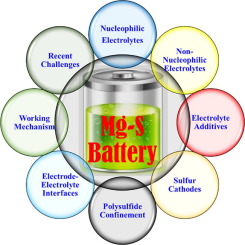Coordination Chemistry Reviews ( IF 20.3 ) Pub Date : 2020-04-07 , DOI: 10.1016/j.ccr.2020.213312 Muhammad Rashad , Muhammad Asif , Zeeshan Ali

|
The emerging energy-storage technologies must meet the requirement of low cost, reasonable safety, high natural abundance, and high energy density. The rechargeable magnesium-sulfur battery (Mg-S) meets these requirements as a new and emerging technology because of its high specific energy (1722 Wh. kg−1) and dendrite free plating/stripping of magnesium anode. However, its performance is restrained by the sluggish magnesium ion diffusions and unavailability of high-voltage magnesium electrolytes compatible with sulfur cathodes. As a result, Mg-S batteries suffer from poor reversible capacity and cycle life. Furthermore, the formation of magnesium polysulfide (Mg-PS) is considered as a biggest R&D challenge for Mg-S batteries. To alleviate these problems, numerous breakthroughs and achievements have been made in the past five years. This review covers the research and development to date on Mg-S systems including working mechanism, development of nucleophilic and non-nucleophilic electrolytes, inorganic electrolyte additives, fabrications of sulfur cathodes, effect of binders, polysulfide confinement via cathode or separator treatments, and in-situ characterizations of electrode/electrolyte interfaces. The electrochemical properties of newly developed Mg-S systems are debated in terms of cell configuration, composition of electrolyte, specific capacity, cycle performance, over potential and working voltages. Furthermore, the current challenges and possible research gaps in Mg-S systems are critically discussed along with future perspectives. We hope this review will revolutionize the deep understanding of Mg-S battery and open the new horizons to develop the highly efficient cathodes and electrolytes in near future.
中文翻译:

寻求镁硫电池:电解质和阴极材料开发中的当前挑战
新兴的储能技术必须满足低成本,合理的安全性,高自然丰度和高能量密度的要求。可充电镁硫电池(Mg-S)由于其高比能(1722 Wh。kg -1)和镁阳极无枝晶电镀/剥离。然而,其性能受到缓慢的镁离子扩散和与硫阴极相容的高压镁电解质的缺乏所限制。结果,Mg-S电池的可逆容量和循环寿命差。此外,多硫化镁(Mg-PS)的形成被认为是Mg-S电池最大的研发挑战。为了缓解这些问题,过去五年来取得了许多突破和成就。这篇综述涵盖了迄今为止对Mg-S系统的研究和开发,包括工作机理,亲核和非亲核电解质的开发,无机电解质添加剂,硫阴极的制造,粘合剂的作用,通过阴极或隔板处理的多硫化物限制,电极/电解质界面的原位表征。关于新开发的Mg-S系统的电化学性质,在电池配置,电解质成分,比容量,循环性能,电势和工作电压方面存在争议。此外,对Mg-S系统的当前挑战和可能存在的研究差距以及未来的观点进行了严格的讨论。我们希望这次审查将彻底改变对Mg-S电池的深刻理解,并为在不久的将来开发高效阴极和电解液打开新的视野。此外,对Mg-S系统的当前挑战和可能存在的研究差距以及未来的观点进行了严格的讨论。我们希望这次审查将彻底改变对Mg-S电池的深刻理解,并为在不久的将来开发高效阴极和电解液打开新的视野。此外,对Mg-S系统的当前挑战和可能存在的研究差距以及未来的观点进行了严格的讨论。我们希望这次审查将彻底改变对Mg-S电池的深刻理解,并为在不久的将来开发高效阴极和电解液打开新的视野。











































 京公网安备 11010802027423号
京公网安备 11010802027423号